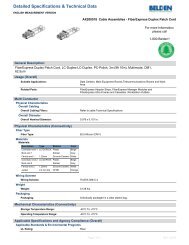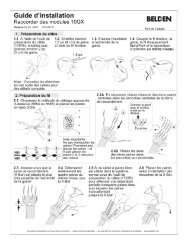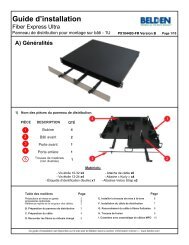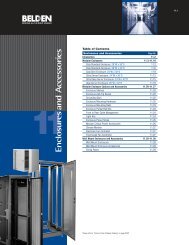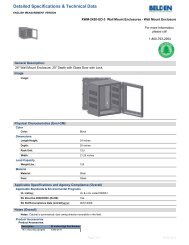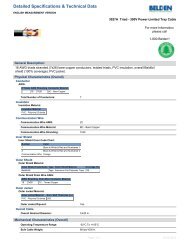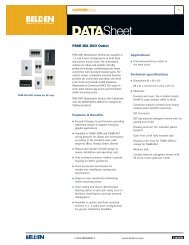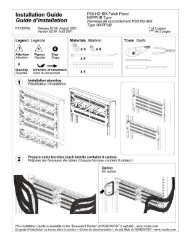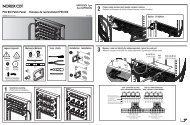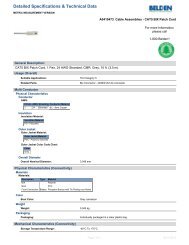19. Broadcast Cables - Belden
19. Broadcast Cables - Belden
19. Broadcast Cables - Belden
You also want an ePaper? Increase the reach of your titles
YUMPU automatically turns print PDFs into web optimized ePapers that Google loves.
B R I L L I A N C E ® B R O A D C A S T C A B L E S <strong>19.</strong>31<br />
Speaker Wire and Cable<br />
Overview<br />
Electrolytic Tough Pitch (ETP)<br />
High-conductivity Copper Speaker <strong>Cables</strong><br />
Speaker cables are used to connect receivers or power<br />
amplifiers to speakers and are also used for the internal wiring<br />
of the speakers themselves.<br />
High-conductivity Copper<br />
All <strong>Belden</strong> ® speaker cables utilize only high-conductivity copper<br />
produced by a process called Electrolytic Tough Pitch. This refining<br />
process produces a conductor that is 99.95% pure copper resulting<br />
in high-conductivity per ASTM B115. The high purity obtained from<br />
ETP copper results in audio cable performance that is comparable<br />
to that of oxygen-free copper cables.<br />
Gage Selection<br />
Because the impedance of the loud-speaker is quite low (typically<br />
3 to 10 ohms) much of the power conducted through the cable<br />
is carried in the current domain which is affected by conductor<br />
resistance. The resistance of the cable between the speaker and<br />
the amplifier turns some of the amplifier’s power into heat and<br />
does not get to the speaker.<br />
The feedback from the speaker is altered by the cable. This feedback<br />
is used by the amplifier to correct the speaker’s non-linearity. It is<br />
measured as the Damping factor by amplifier designers and is called<br />
“Servoing” by the Hi-Fi community.<br />
In general, the higher the cable resistance, the lower the power<br />
level getting to the speaker, resulting in “sloppier” speaker<br />
performance due to damping.<br />
Ultimately, the system designer must decide how to compromise<br />
system performance against system cost. In general, one of the<br />
least expensive ways to squeeze more and better performance out<br />
of the system hardware is to use larger speaker cables and cut your<br />
losses where they occur rather than try to “Band-Aid” the system<br />
later with equalization or more power.<br />
The Cable Selection Guide can aid in determining the proper gage<br />
selection depending on the speaker impedance, acceptable power<br />
loss and cable run length.<br />
Speaker Cable Selection Guide<br />
AWG<br />
11%<br />
.5<br />
4Ω Speaker<br />
8Ω Speaker<br />
Power (%) / Loss (dB/Ft.)<br />
For more information, contact <strong>Belden</strong> Technical Support: 1-800-BELDEN-1 • www.belden.com<br />
21%<br />
1.0<br />
50%<br />
3.0<br />
11%<br />
.5<br />
21%<br />
1.0<br />
50%<br />
3.0<br />
11%<br />
.5<br />
70V Speaker*<br />
21%<br />
1.0<br />
50%<br />
3.0<br />
12 140 305 1150 285 610 2285 6920 14890 56000<br />
14 90 195 740 185 395 1480 4490 9650 36300<br />
16 60 125 470 115 250 935 2840 6100 22950<br />
18 40 90 340 85 190 685 2070 4450 16720<br />
20 25 50 195 50 105 390 1170 2520 9500<br />
22 15 35 135 35 70 275 820 1770 6650<br />
24 10 25 85 20 45 170 520 1120 4210<br />
The number of feet of cable you can run for a given loss and performance budget.<br />
How to Use the Guide<br />
Step One Select the appropriate speaker impedance column.<br />
Step Two Select the appropriate power loss column<br />
deemed to be acceptable.<br />
Step Three Select the applicable wire gage size and follow the row<br />
over to the columns determined in steps one and two.<br />
The number listed is the maximum cable run length.<br />
Example The maximum run for 12 AWG in a 4 Ohm speaker<br />
system with 11% or .5 dB loss is 140 ft.<br />
*70 volt line drive systems, while considered a potential for Hi-Fi performance,<br />
follow the same cable loss physics as the higher current (lower impedance) system.<br />
For the sake of this calculation a 25 watt 70 volts system (196Ω) was used.<br />
19 • Brilliance ® <strong>Broadcast</strong>



